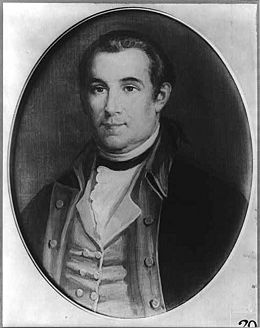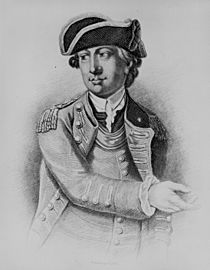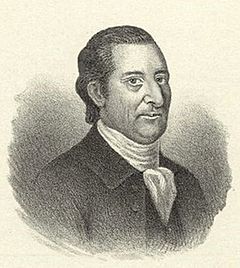Eleazer Oswald facts for kids
Quick facts for kids
Eleazer Oswald
|
|
|---|---|

Eleazer Oswald
|
|
| Born | 1755 England |
| Died | 30 September 1795 (aged 39–40) New York City, New York |
| Allegiance | |
| Service/ |
Artillery |
| Years of service | |
| Rank | |
| Battles/wars |
|
Eleazer Oswald (1755 – 30 September 1795) was born in England. He moved to America when he was young. He became a printer's apprentice and later married his boss's daughter.
When the American Revolutionary War began, Oswald quickly joined the American colonists. He fought in Benedict Arnold's expedition to Quebec in 1775 and was captured. After being exchanged, he became a lieutenant colonel in the artillery in 1777. He served bravely during the Danbury Raid in Connecticut in April 1777. He also played a big part in the Battle of Monmouth in June 1778.
After leaving the army, Oswald returned to his work in printing and journalism. He published newspapers in Baltimore, Philadelphia, and New York. In 1792, he went to France and joined the French Revolution. He became a colonel and led an artillery unit. He fought at the Battle of Jemappes and then went on a secret mission to Ireland. He returned to New York in 1795 and sadly died from Yellow Fever.
Contents
Early Life and Military Service
Eleazer Oswald was born in Falmouth, England, in 1755. His father was a ship captain who disappeared at sea when Eleazer was a teenager. Around 1770, Oswald traveled to America and became involved with the American patriots. He settled in Connecticut and became an apprentice to a printer named John Holt in New York. Oswald married Holt's daughter, Elizabeth, in 1772. Their first son, John Holt Oswald, was born around 1777.
Soon after the Battles of Lexington and Concord, Oswald joined the American army. He was with Benedict Arnold when they captured Fort Ticonderoga on May 10, 1775. Oswald then joined Arnold's expedition to Quebec in 1775 as a volunteer. On December 31, 1775, he fought in the Battle of Quebec. He was wounded and captured during the battle.
Oswald was exchanged as a prisoner on January 10, 1777. He then became a lieutenant colonel in John Lamb's artillery regiment. He showed great courage at Compo Hill during the Danbury Raid. His three-gun battery bravely tried to stop a British attack.
Oswald was the main artillery officer for General Charles Lee at the Battle of Monmouth on June 28, 1778. He commanded several artillery units during the battle.
General George Washington first put Marquis de La Fayette in charge of the American advance guard. But General Lee, who was Washington's second-in-command, asked for the role. Washington then gave Lee command of 5,500 troops. On June 27, Washington ordered Lee to attack the British army's rear guard the next morning.
On June 28, Lee's troops started marching early. Oswald's four guns were part of the first attack. They pushed back some British soldiers but then came under fire. Two of Oswald's guns were left exposed. Lee sent more troops to support Oswald's guns.
Around 10:30 AM, Lee saw that the British army, led by Sir Henry Clinton, was advancing with 6,000 soldiers. Lee felt his troops might not be ready to stop them. Oswald began moving two of his guns back because one was broken, and the crews were tired and out of ammunition. Lee approved this move. Other American units also started to fall back. Lee then ordered a general retreat. Oswald quickly gathered 10 cannons to cover the American withdrawal.
As the retreat continued, Oswald received orders to hold his position and then to keep falling back. He split his cannons, sending some to support other brigades. Around 11:00 AM, Washington arrived and learned of Lee's retreat. Lee tried to set up a new defense line. Oswald placed two of his remaining four guns on a hill to support the troops there. The other two guns covered other American soldiers.
The British Guards attacked and pushed back some American troops. The fighting then focused on a hedgerow. Oswald's guns fired grapeshot at the British from very close range. The British troops eventually overran the hedgerow. The British commander of the 2nd Grenadiers was killed by grapeshot. Washington's artillery chief, Henry Knox, ordered Oswald to pull his cannons back across a stream. Despite the retreat, no American guns were captured by the British. For the next two hours, American and British cannons fired at each other. Oswald's actions at Monmouth were praised in official orders.
After the battle, General Lee was put on trial by a court martial. He was accused of disobeying orders and making an unnecessary retreat. Oswald, Knox, and others spoke in Lee's defense. However, Lee was found guilty and suspended from command for one year. He was later dismissed from the army.
Journalism and Later Military Service
After the Battle of Monmouth, Oswald left the army. He felt he should have been promoted. He joined William Goddard at the Maryland Journal newspaper. While there, he printed General Lee's criticisms of Washington, which caused a public outcry.
Oswald then moved to Philadelphia in 1782. He started his own newspaper, the Independent Gazetteer, or the Chronicle of Freedom. This newspaper was very strong in its political opinions. In 1783, he also started printing the Price Current, which might have been the first business newspaper in the United States.
In 1788, Oswald faced a legal challenge for printing anonymous accusations against a school headmaster. Oswald refused to name his sources. He printed a statement defending the "rights of the press and of freemen." He argued that limiting the press was against freedom. The court found him in contempt and sentenced him to one month in jail and a fine. This case helped define the limits of court power over the press later on.
During and after the Constitutional Convention in 1787, Oswald first supported the new Constitution. But later, he printed articles that were critical of it. His newspaper was one of only a few that regularly published essays against the Constitution. These essays, written by someone called Centinel, argued against adopting the United States Constitution.
Oswald later moved to New York City and published another newspaper. He wrote against Alexander Hamilton, and a duel between them was almost fought but stopped by friends. In 1792, Oswald traveled to England and then to France.
On September 18, 1792, Oswald received a colonel's rank in the French army. He fought at the Battle of Jemappes on November 6, 1792, where he commanded four artillery units. Cannons caused most of the enemy casualties in that battle. He later commanded 12 artillery units in another battle. On January 16, 1793, he left the army for a secret mission for the French government. From February to June 1793, he was in Ireland. He reported on people's unhappiness with the British government. Because he was American, he could do his spy work without being suspected.
Documents show that Oswald asked the French government to pay him back for his mission expenses. Thomas Paine wrote a letter saying Oswald's reason for helping France was to repay them for their help in the American War of Independence. Oswald returned to New York City and died there from Yellow Fever on September 30, 1795.
Family
Eleazer Oswald and his wife Elizabeth Holt had seven children. Their oldest son, John Holt Oswald, became an international merchant. He died in 1810 and had three children. Another son, William Hunter Oswald, also worked in international trade. He was working in Trieste, on the Adriatic Sea, in 1815. Thomas Oswald died without children. Ann never married, and Phoebe died as a baby. Rebecca married a man named Glenn, and Elizabeth married Dr. George Balfour, who joined the United States Army.
Images for kids







